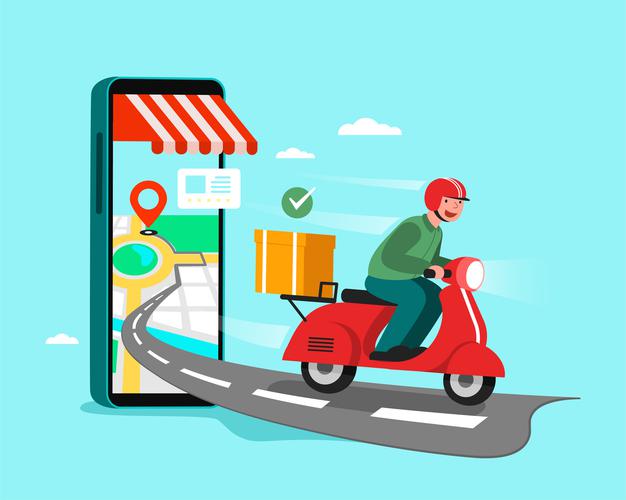Food delivery services fee have always posed a tunnel vision to customers. They tend to believe that the said name-brand restaurant is making a hefty profit – and that too on a whim, without any accountability factor.
However, we wanted to present things to you from the restaurants’ perspective. If you have been in such a dilemma as a customer, where there isn’t the slightest inclination about how restaurant food delivery services fee work, and why “all of a sudden”, they are imposing an unusual fee on your favorite food items, then this post is for you.
More importantly, if you are a restaurant owner, you can cut down on your overhead online fee at the hands of shady partner merchants by teaming up with alternative services like Blink Co.
Read on…
The pricing matrix behind the food delivery business
Not that the restaurant industry wasn’t growing pre-COVID-19 but studies by Wall Street Journal show that the average user is paying more for the individual order than in 2019.
The study had some interesting insights. Three identical orders were placed from Doordash, Postmates and Grubhub in both 2019 and 2021. All three orders had gone up in price, both with respect to food costs and the service fees.
If you’re wondering what are the core components of pricing across food delivery apps:
- Menu Item: The Food that you’re ordering
- Service Fee: The fee charged by the delivery company for providing the service
- Taxes: Sales tax for your order based on local tax regulations
- Delivery Fee: the price charged for delivery the food
- Gratuity: Any tip you might want to give to the delivery driver
The Science Behind “Exorbitant” Food Delivery Services Fee from Restaurants’ Perspective:

During the last 13 months in the U.S. F&B (Food and Beverage) market, L.A. time reported that there were tons of business operators who seemingly struggled with paying online rentals!
Yes, you read that right. Online rentals come in the form of hefty percentages that mobile food ordering platforms charge without prior notices. Sometimes, they have such policies outlined in their terms and conditions page where the partnership tenure usually begins at a very nominal fee for rendering services to restaurant owners.
In a way, food business startups were affected the most, especially if they founded their business during the aftermath of the Covid-19 pandemic. The “cost” of doing business assumed a heart-wrenching situation for such food businesses because they have no other option but to abide by the policies stipulated by online merchants and third-party food delivery portals.
Additional Reading: Behind the Delivery App Wars: A De-facto Cartel
Jenn Harris’s recent story focused on mainstream restaurants’ struggle to keep up with monetary pressures from all sides. “For many restaurants, these food delivery apps provide a service that they cannot simply facilitate on their own. However, the tally of charges during fiscal years has been a shock to many,” said Harris.
This isn’t something new. Needless to say, the outcry concerning food services fees is not only limited to the U.S. restaurant marketplace.
Things are pretty much the same in South Asia, the Middle East, and other parts of the world.

For instance, in Pakistan, Food Panda is the pioneering aggregator that connects a multitude of restaurants with millions of customers from all over the country. However, what a majority of customers don’t know is Food Panda’s fee structure that goes into effect whenever a restaurant partners with the company.
According to insiders, Food Panda charges a flat 25% commission per order to restaurants. This commission percentage is enacted regardless of the size of the online food order. As a result, while restaurants have to squeeze in that percentage as part of the “food services fee”, customers only end up seeing a hefty price tag on their favorite menus.
Meanwhile, Dubai-based F&B business owners have to pay service charges to partner portals, or merchants, if you’d like to call them that, by up to a whopping 35% on a per order basis.
“It’s way too high” according to a Gulf News correspondent who wrote a stellar feature on Dubai’s food industry dilemma after it transitioned to online food ordering systems.
That’s not the worst of it. Dubai’s small and mid-sized restaurant business operators are looking for alternatives that don’t charge as much as their previous partners. More so, a lot of these business owners are planning to cut ties with the industry and switching over to other businesses that don’t incur such high fee in the long run.
Their plan is to stop taking orders coming in from Uber Eats, Deliveroo, Zomato, and other popular Dubai online food ordering apps for days on end. This action will serve to show the seriousness of F&B business owners’ intent. After all, it’s the only choice under such dire circumstances.
Online Food Service Charges Come Close to 12.5 – 35% for Dubai Food Businesses:

At the moment, food and beverage operators, especially from the small business communities, unanimously agree that they all have to pay flat commissions on each order. These commissions start from 12.5% and go all the way up north of 35%, which literally leaves no room for profits or whatsoever. As a result, instead of scaling up, either the said restaurant owner collapses under pressure, or fails to bank on ideal online food marketing strategies at the right time.
Top it all off with a side of strict rules from government health institutes that prevent customers from venturing out of their residencies. In times like these, restaurants have no other choice but to comply with third-party mobile food order booking apps in hopes of seeing light at the end of the tunnel.
Statistically speaking, the volume of business has shrunken for Dubai, the U.S., and South Asian restaurant owners. Meanwhile, the number of orders coming in from online food customers has been at an all-time high, which is only just part of the entire picture.
In reality, the revenue stream coming in from these online orders goes towards foodservice merchants that are responsible for billing restaurants in the first place. You should be surprised to see one of your favorite restaurants vanish from the radar without any prior signals. It’s just how the usual scenarios pan out these days for many F&B operators across the globe.
[INSERT_ELEMENTOR id=”2061″]
There’s No ‘Put a Cork in It’ Possibility to Prevent Profit Leaks:
An agreement with an online food services portal instigates some sort of percentage that has to be paid on a per order basis. Without naming names, one such vendor charges a minimum of 5% that has to be agreed upon by restaurant owners at the time of signing up for an account at the merchant’s website.
In January 2021, back in the U.S., Assembly Woman, Lorena Gonzalez helps to pass the bill: AB 286 that created a Statewide food services fee in the form of a 15% cap on the menu listed prices for online orders.
Meanwhile, famous ‘Hui Tou Xiang’ restaurant owner, Jack Li, had to pay $21,000 to Grubhub, $14,000 to Postmates, and up to 35% food services fee to DoorDash. Li, who was used to walk-in customers waiting in line during rush hours, has no choice but to abide by policies that were set in motion due to AB 286.
On top of that, when food and business owners from the U.S., the Middle East, and South Asia call app owners to negotiate the pricing model, it doesn’t end up well. Usually, these companies reroute the calls to offshore “account specialists” who just churn out the usual copy-pasted policies without ever getting back to address the problem in the first place.
For instance, one restaurant owner from Dubai noticed a change in food services fee. He said that he ended up paying 16% in October 2020 to his online vendor. However, it didn’t stop there. The said name-brand restaurant owner, had to pay 17% in November and 18% in December without any signs of de-escalation in the food services fee model.
For most business owners, it’s hard to catch up on the ever-evolving food services fee model. The vendors/ merchants change the fee without sending out a formal notification. Even if they do send a heads-up to the restaurant, it’s already too late by then. Especially, if that restaurant is working in agreement with three to four different services at the same time, the ability to monitor food services fee changes falls down to an inhuman task.
The Hidden Costs of Food Delivery Services – Why you need your own app
The advent of the internet and recently, the pandemic enforced lockdowns around the world have honestly just changed the way how people order found around the world.
With access to restaurants limited – people and businesses have had to look for alternatives, and food delivery services are one such solution.
The benefits of food delivery services are evident from the consumer perspective – not only are the service providers fast but they allow consumers to enjoy the food at the comfort of their homes.
From a restaurant point of view, food delivery services is an economy ideal for creating new revenue streams and provide the business with exposure in different markets.
Online Order Handling Charges
An online order handling charge is one of the most common hidden food delivery fees. This is a fee that some restaurants charge for orders placed online or through a delivery service. While this fee may not seem like much, it can add up over time – especially if you order from multiple restaurants.
Fortunately, Blink does not charge any hidden online order handling fees. So, you can order from as many restaurants as possible without worrying about extra charges. It charges a minimal commission on every order placed from Blink, but that, compared to other food aggregators, is a tiny percentage.
Where Foodpanda charges 40% commission per order, Blink charges 1-2% only. The difference is so commendable that restaurants should not think twice of switching to Blink for their online order management services.
With so many benefits of using Blink over other food delivery services, it is worthwhile to mention that Blink’s charging mechanism is very transparent. Blink allows restaurants to display their menus in no time. It provides a white-labelled app and website to the merchants after onboarding them, and that too within 24 hours of having them on Blink.
Meaning they are present online in a short period of time. A white-labelled app allows merchants to display the products however they like. They can put up promotions and discounts however and whenever they want. They can play with the visual architecture on the app ad see what works for them and what does not through heat maps.
With very little commission from the restaurant owners, their profit margin can be maximized. From a customer’s perspective, you can order from multiple restaurants without having to worry about extra charges. Second, Blink offers a wide range of restaurants to choose from.
Whether you’re in the mood for Chinese or Thai food, you’re sure to find something you’ll enjoy on Blink. Third, Blink offers fast and reliable delivery. So if you’re ever in a hurry, you can rest assured knowing that your food will be delivered quickly and efficiently.
Postmates Hidden Fees
Postmates is a food delivery service in many major cities across the United States. Customers can order food from participating restaurants and deliver it to their doorsteps. Postmates has been praised for its convenience, but some customers have complained about hidden fees.
One of the most common complaints about Postmates is the online order handling charge. This fee is not listed on the restaurant’s menu and can add up to a significant amount if you’re ordering multiple items. The online order handling charge is currently $0.99 per item.
Another common complaint about Postmates is that they add hidden fees to your bill. These fees can include a delivery fee, a service fee, and a tip. The delivery fee is typical $0.99 per order, but it can be higher if you live in a rural area.
The service fee is typically 15% of your total order, and the tip is optional but appreciated by the driver. Some customers have reported being charged additional costs on the delivery fee. These additional fees can include an online order handling charge, a service fee, and even a tip. While Postmates does not explicitly state that these additional fees may be charged, it is essential to be aware of them before using the service.
Why you need your own Food Delivery App
Food delivery apps fulfill a vital niche between the restaurant and its customers. Many of the large chains like McDonald’s, SubWay, Domino’s already have their own branded apps. This provides these restaurant chains a greater level of control and lets them connect to their customers in a more efficient manner.
Who can benefit from a Food Delivery App?
While some restaurants do have their own food delivery apps – here are a couple of reasons for you to have your very own if you’re still stuck with aggregators.
- Restaurant Chains
- Local Restaurants
- Startups and Entrepreneurs
12 Advantages of to have your own Food Delivery App
- Easy and Smooth Customer Experience
- Increase check sizes: Restaurants see a 20% increase in check sizes from delivery apps versus dine in orders.
- Make up for reduced foot fall to your restaurant
- More business opportunities
- Exposure to new customers and markets
- There is no real bar for targeting customers
- Build a visible brand
- Boost to customer retention
- Make better bargains
- Book Tables for Outdoor lunch or dinner
- Cashless Mobile Commerce Experience
- Granular Level Quality Control
Here’s How Blink Co Is Helping Restaurants to Battle the Hidden Food Delivery Fee Dilemma in The Middle East:

Founded in 2020, the privately held aggregator is becoming increasingly popular among restaurants, especially in the MENAP zone.
While many restaurants have to rely on their own food handling, pickup, and delivery systems, merchants like Blink Co. have become a go-to favorite for such F&B business owners.
The key is to offer a friendly food delivery services fee model that doesn’t sting the restaurant owner in the long run. Unlike conventional merchants in MENAP regions, Blink Co. reportedly charges a monthly subscription fee to its long line of emerging restaurant businesses.
As a result, these restaurants do not have to go through a similarly harrowing experience as their counterparts in the U.S., South Asia, and other regions of the world. BlinkCo.’s stance on feed delivery fee aims to cushion food business startups that wish to get by with a little action while the post-pandemic online food ordering frenzy is in full swing.
The company’s goal is to ensure what name-brand food business operators can choose what works best for them in terms of logistics and financials.
As a matter of fact, without presenting any concrete evidence to you, it’s all talk. Isn’t it?
If you are a restaurant owner, looking to switch partners, or someone who hasn’t signed up with an online food ordering merchant, here’s what Blink Co. brings to the table for you:
- Multiple Food Ordering Channels: Retain and grow your regulars and first-time customers through your very own white-labeled business space.
- Dedicated Customer Engagement Tools: Blink offers various promotional channels ranging over WhatsApp status messages, promo codes, restaurant-centric discount deals, and other variables to keep customer engagement at its highest possible conversion point.
- Access to Customer Analytics: Get real-time insight on customer buying patterns, their most active time of the day, and other data to gain visibility on scaling the business to the next level. All of this is available in the form of “no fluff” interactive reports that are actually used to restaurant owners’ advantage.
- Interactive Menu Options: Set up your food order menu in 10 – 15 minutes without being tech-savvy. Take it as beginner’s luck or whatever, but Blink’s interface is really simple to navigate for customers and restaurant owners at the same time.
- Dedicated Fleet Management System: Of course, without a real-time tracking system, creating an intuitive food services portal for restaurants wouldn’t have borne results. For customers and business owners, alike, keeping tabs on food delivery agents’ location has never been easier before.
[INSERT_ELEMENTOR id=”2061″]
In addition to offering these perks, Blink Co. braces restaurant owners with multiple integrations that help to monitor incoming payments, order fulfillment, and other activities without any hassle.
Get a full breakdown on extra details and everything there is to set up your own branded app and mobile interface via Blink for Restaurants Webpage today.
Here’s what Taha Anis, Burger King Pakistan’s Executive Director had to say about Blink in its recent reviews. “Blink has helped Burger King Pakistan to tap into the e-commerce space by deploying its technology. We have found the Blink team to be professional and adaptive to our requirements. They have critically supported us in building our go-to-market strategy for our website and app.”
Who Can Benefit from Blink Co. Merchant Services:

While many businesses have already hopped on to Blink Co.’s online food ordering portal, other companies should consider doing the same.
If you happen to be a business owner frustrated with overhead expenses or other food services fee-related issues, here’s how Blink Co’ helps to outshine the competition:
- Restaurant Chains:
Setting up shop with distributed locations over different areas can be a little hard to tackle. If you are the owner of such f chain, you can save on your drivers’ fee and commission fee by signing up with Blink. We charge an all-time low percentage (2% – 2.5%) to accommodate all sorts of operators
- Food Startup with No Footprints:
Startup-level food businesses in the MENAP region are bamboozled by a limited amount of cash. By partnering up with a reasonable merchant that doesn’t charge unannounced hefty percentages can help you to focus on your online marketing strategies and promotional campaigns with unwavering audacity.
- Entrepreneurs Looking for Bleeding Edge Technology:

Today’s entrepreneur is tech-savvy. That means the average business owner adores food services merchants that wear multiple hats by offering a centralized platform for effectively monitoring simultaneous business operations. Blink Co. does exactly that, and more by combining all the prerequisites that are necessary to boost your food business without having to switch between different platforms.
As a seasoned diner, we are not asking you to forgo the convenience of delivery just because the cost is too damn high. However, just so you know, the perspective is very different from your favorite restaurant’s point of view.
To keep your food culture lexicon in motion, feel free to bookmark this post and share it with your friends and coworkers. It’ll help many new and veteran restaurants to switch over to business partners that actually care about them in the first place!
[INSERT_ELEMENTOR id=”2061″]
Related Articles:
 Blink’s Special: Chefs Talking about Restaurant Industry in 2021 & Beyond
Blink’s Special: Chefs Talking about Restaurant Industry in 2021 & Beyond
 5 Reasons Why You Need an Online Ordering System For Business In Food Industry
5 Reasons Why You Need an Online Ordering System For Business In Food Industry
 Top 7 ChatFood Alternatives in 2022
Top 7 ChatFood Alternatives in 2022
 How to Successfully Use Blink’s Restaurant Analytics in Saudi Arabia to Increase Revenue
How to Successfully Use Blink’s Restaurant Analytics in Saudi Arabia to Increase Revenue
 The 7 Best Online Food Ordering Systems In 2023
The 7 Best Online Food Ordering Systems In 2023




